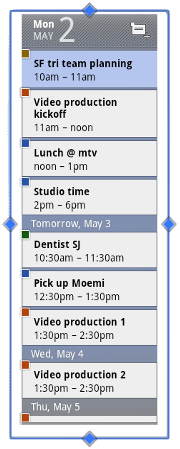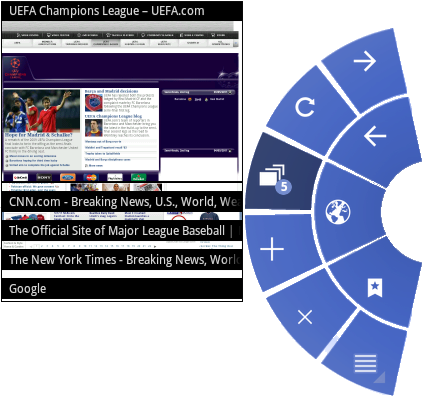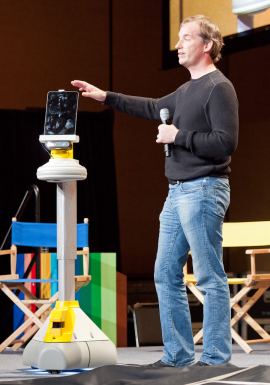Android 3.1 released, as Ice Cream Sandwich waits in the wings
May 10, 2011 — by Eric Brown — from the LinuxDevices Archive — 1 views[Updated: May 11] — At the Google I/O conference, Google announced Android 3.1, an update that fixes bugs, tweaks the UI, improves USB support, and adds an Arduino-based Android Open Accessory gadget control platform. Briefly tipping an upcoming “Ice Cream Sandwich” release that will integrate Android 2.x and 3.x, Google also announced Android Market movie rentals, an 18-month Android upgrade program, and an [email protected] home-automation framework.
On day one of its Google I/O conference in San Francisco, Google announced a dizzying array of new Android-related initiatives — ranging from a home automation platform to the ability to download movies on Android Market. Google also announced a plan to makes updates more timely on Android devices (see farther below).
The event, which featured a giveaway of Samsung Galaxy Tab 10.1 "Limited Edition" tablets to over 5,000 attendees, also unveiled a new "Music Beta by Google" service, which we are covering in a separate Music Beta report.
Google also announced some interesting stats for Android:
- 100 million activated Android devices
- 400,000 new Android devices activated every day
- 200,000 free and paid applications available in Android Market
- 4.5 billion applications installed from Android Market
So yeah, the industry can wring its hands over fragmentation, lawsuits, and other ongoing problems with Android, but that hasn't stopped people from buying Android devices in droves.
Android 3.1: Will it satisfy the critics?
One major problem for Android appears to be at least partially addressed by the most concrete development of the day: the arrival of Android 3.1. The update will start rolling out to Motorola Xoom tablet users today. Android 3.1, which upgrades the promising, yet troubled, tablet-oriented Android 3.0 ("Honeycomb"), appears to fix many of the bugs and UI head scratchers that have helped lead to slow sales of Motorola Mobility's Xoom.

Android 3.1
 Among other UI fixes, touching the Home button in the system bar now brings users to the most recently used home screen, and there's an improved view of internal storage, showing the storage used by a larger set of file types, says Google. The Recent Apps list is now expandable, letting users scroll the list to see thumbnail images of all tasks in progress and recently used apps, says Google.
Among other UI fixes, touching the Home button in the system bar now brings users to the most recently used home screen, and there's an improved view of internal storage, showing the storage used by a larger set of file types, says Google. The Recent Apps list is now expandable, letting users scroll the list to see thumbnail images of all tasks in progress and recently used apps, says Google.
In addition, Home screen widgets are now said to be resizable using drag bars. They can even be expanded to include more content, when supported by the widget in question (see image at left).
On the hardware front, Android 3.1 adds USB host support, as well as automatic hardware detection to support more USB accessories. Users can now attach "almost any type of external keyboard or mouse," and support has been added for PC joysticks and gamepads that are connected over USB or Bluetooth, says the company.
Android Open Accessory API
A related announcement was an Android Open Accessory application development kit (ADK), whichs enables any USB-connected accessory designed with the API to interact with Android 3.1 devices. The ADK has also been backported to Android 2.3.4.
Ably explained in I-Programmer, and more fully fleshed out on Google's Android Open Accessory site, the ADK builds upon the enhanced USB skills of Android 3.1 and Android 2.34 to help developers create Android hardware peripherals that connect to the device via USB, enabling the devices to act as a USB host.
A hardware reference design kit for the API will be based on the Arduino open source gadget platform, so initially at least all the external devices must use this popular microcontroller platform.
In addition to the new USB-related API and ADK, new developer-focused features include improved support for external cameras and audio streaming. Performance is also been improved with a variety of techniques, including a new "LRU cache class," claims Google. More details on the new Open Accessory API and other new developer features may be found on this Google Android 3.1 SDK tools overview.
Wi-Fi still runs when device is idle
Android 3.1 adds a Wi-Fi lock feature that enables a continuous Wi-Fi connection even when the device the screen is turned off. This enables users "to play continuous streamed music, video, and voice services for long periods, even when the device is otherwise idle," says Google.
A new Preferred Network Offload (PNO) background scanning capability conserves battery power in such situations, says the company. Other Wi-Fi enhancements include the ability to configure an HTTP proxy for each Wi-Fi access point.
Application enhancements include an updated Browser with a redesigned Quick Controls UI that lets users view thumbnails of open tabs and then close the active tab (see image below). The feature is also said to enable access to the overflow menu for instant access to settings. The Browser also adds support for CSS 3D, animations, and CSS fixed positioning standards, as well as embedded playback of HTML5 video content, says Google.

Android 3.1 BrowserQuick Controls UI
There was apparently no word on when Android 3.0 or 3.1 would be released as open source code, an event that Google said would be delayed indefinitely back in March.
According to a PCWorld report by Melissa Persenson, many of the Honeycomb problems identified by reviewers do not appear to have been addressed in the new release. These include "the image rendering glitch that's very obvious in the Gallery app, where images appear fuzzy and lack detail as compared with their original versions," writes Perenson.
She also notes that the "poorly designed back button" still appears to exit apps, instead of leaving them running in the background.
On the other hand, Perenson welcomes the resizable widgets, USB host support, and improved quick access button. The latter now lets users "scroll amongst your recent tasks, instead of being limited to the number that fit on the screen."
Google TV gets Android 3.1
Google also announced that Google TV users would be getting Android 3.1 this summer, according to Engadget. Google said that developers will be able to use the vanilla Honeycomb SDK to build apps for Google TV, and also announced hardware partners including Samsung, Vizio, Logitech, and Sony.
More details are expected tomorrow, says the story, which speculated that Google might offer more information on a possible ARM version of Google TV, which is currently based on the Intel Atom CE4100 chipset.
Android "Ice Cream Sandwich" up next
As had been previously tipped, the next major release of Android will be code-named Ice Cream Sandwich, Google now confirms. The platform will apparently unify the 3.x and 2.x platforms, and work on both smartphones and tablets. This would suggest that 3.1 may be the end of the line for 3.x. This integrated platform has been speculated to be called Android 2.4 by some and 4.0 by others, although Android 3.2 might be a possibility, as well.
"Our goal with Ice Cream Sandwich is to deliver one operating system that works everywhere, regardless of device," writes Hugo Barra, Android Product Management Director, in his overview of Google's first day of Google I/O announcements. "Ice Cream Sandwich will bring everything you love about Honeycomb on your tablet to your phone, including the holographic user interface, more multitasking, the new launcher and richer widgets."
There were no more details offered, nor were many more unveiled at the Google I/O event, according to PCWorld's Ginny Mies. Google did, however, show an Ice Cream Sandwich 3D holographic user interface that uses head-tracking to "detect where you're looking on the display and update to match your perspective," writes Mies. "No matter where you are looking on the display, the software will adapt to ensure that you have a perfect viewing experience," she adds.
Google I/O demo of upcoming Android Ice Cream Sandwich head-tracking feature
Source: Engadget
Another touted feature was a Virtual Camera Operator app, which during a multi-part video chat can identify who is speaking and automatically focus on them, says the story.
According to Mies, Google offered no timetable for Ice Cream Sandwich. However Engadget suggested it would be the fourth quarter. Engadget's live blog report included an image of the headtracking demo mentioned above (see above).
Android Market gets movies — and device owner may get more timely updates
Google also announced it is adding movie rentals to Android Market. Starting today, thousands of movies starting at $2 a pop will be available, says the company. Users can rent a movie on their home computers, and then view it on their tablet or phone. Xoom users will get the feature today, and the update will roll out to Android 2.2 and above devices in the coming weeks, says Google.
Movies are fine and dandy, although Android users can find other sources for those. What they really want, however, is more timely Android updates, and only Google and its vendor and carrier partners can help there. Fortunately, help is coming, says Google, in the form of a new 18-month upgrade scheme.
Founding Open Handset Alliance (OHA) partners including Verizon, HTC, Samsung, Sprint, Sony Ericsson, LG, T-Mobile, Vodafone, Motorola, and AT&T, are "working together to adopt guidelines for how quickly devices are updated after a new platform release, and also for how long they will continue to be updated.," writes Google's Barra his blog.
Participating partners "will receive the latest Android platform upgrades for 18 months after the device is first released, as long as the hardware allows," adds Barra. "That's just the beginning. Stay tuned for more details," he adds.
At Google I/O Google also previewed an initiative called [email protected], which allows Android apps to "discover, connect and communicate with appliances and devices in your home," writes Google's Barra. Google showed a preview of Project Tungsten, an Android device for the new Music Beta service that offers more control over music playback within the [email protected] network.
According to an Engadget report, Google's [email protected] team discussed scenarios such as lights "turning on and off based on calendar events, applications talking to washing machines, games automatically adjusting for mood lighting, and basically little green dudes taking care of all the menial duties in your house."
Most impressive, said Engadget, was the Tungsten demo, which scanned RFID tags embedded in CD cases to enable an Android device to detect the CD content and add it to one's Music Beta library.
It all appeared to be rather vague, but Google said the platform would be more formally announced later this year. Neither ZigBee or Z-wave short-range wireless was mentioned, says the Engadget report, which lacked any mention of NFC support, either.
According to CNET, the [email protected] demo featured an LED bulb from Lighting Sciences Group implanted with a radio chip that runs a new mesh network wireless protocol. The demo showed an Android phone turning the lights on and off.
iRobot taps Motorola Xoom for robot
Finally, according to another CNET story, iRobot CEO Colin Angle showed off a robot prototype at Google I/O called AVA that uses an Android-based Motorola Xoom tablet for its computer, camera, audio, and sensor functions. Expected to reach market in a developers package by the end of the year, the robot can move up to two meters per second, and avoid moving obstacles, says the story.

iRobot CEO Colin Angle showing iRobot's AVA prototype with Xoom tablet head
Source: CNET
Availability
More information on Android 3.1 may be found on Google's Android 3.1 highlights page.
This article was originally published on LinuxDevices.com and has been donated to the open source community by QuinStreet Inc. Please visit LinuxToday.com for up-to-date news and articles about Linux and open source.